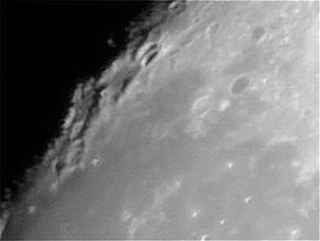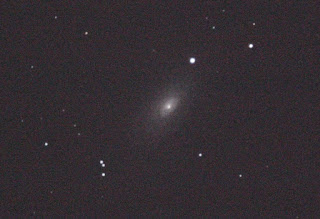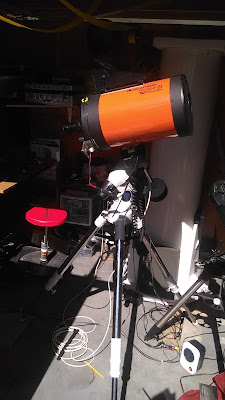Can you believe it, TWO nights in a row!
Since the new setup with the marriage of the NexStar 8iSE and the Meade LXD-75 GEM worked out so well the previous night, I decided to use this evening to attempt some astrophotography with my Canon t3i. My setup up was the scope with a Celestron f/6.3 reducer, which would give a wider field of view than at prime focus and also shorted the exposure times. The down side is that what I capture would be half the size compared to photographing at prime focus. But for this evening I wasn't concerned about that. Instead I just wanted to see how this setup worked photographically.
My first target was Messier 5 or M5 (also designated NGC 5904) is a globular cluster in the constellation Serpens. Under extremely good conditions, just visible to the naked eye as a faint "star" near the star 5 Serpentis. Binoculars or small telescopes will identify the object as non-stellar while larger telescopes will show some individual stars, of which the brightest are of apparent magnitude 12.2. M5 was discovered by the German astronomer Gottfried Kirch in 1702 when he was observing a comet. Charles Messier also noted it in 1764, but thought it a nebula without any stars associated with it. William Herschel was the first to resolve individual stars in the cluster in 1791, counting roughly 200.
M5
This was only a 1 minute 10 second exposure made up of 7 - 10 sec exposures at ISO 3200 that were stacked in software known as DeepSkyStacker Live. You can see the various colors of different stars in this image, blues and oranges. More detail would have resulted from more exposures, so I will revisit M5 in the future photographically.
With that success I moved on to M3. Messier 3 (also known as M3 or NGC 5272) is a globular cluster of stars in the northern constellation of Canes Venatici. It was discovered by Charles Messier on May 3, 1764,[8] and resolved into stars by William Herschel around 1784. Many amateur astronomers consider it one of the finest northern globular clusters. This cluster is one of the largest and brightest, and is made up of around 500,000 stars. It is estimated to be 8 billion years old. It is located at a distance of about 33,900 light-years away from Earth.
M3
I was surprised by how bright M3 was compared to M5! This is a 1 minute 40 sec exposure created from 10 - 10 sec subs at ISO 3200. Again, notice the various colors of the stars in this cluster. Quite a jewel box !
Well, that was fun! But the evening (55 degrees F) had just begun! Sure, star clusters are easy to image but dimmer objects like distant galaxies were on my mind... so...on to GALAXIES!
First up, galaxy-wise, was M51. M51 (aka "The Whirlpood Galaxy") has always been one of my favorite galaxies to view in a big telescope. It is one of the best known galaxies in the sky. The galaxy and its companion, NGC 5195, are easily observed by amateur astronomers, and the two galaxies may even be seen with binoculars under clear and dark skies! The Whirlpool Galaxy is also a popular target for professional astronomers, who study it to further understand galaxy structure (particularly structure associated with the spiral arms) and galaxy interactions.
M51 - The Whirlpool Galaxy
This galaxy is found inside the arc that makes up the Big Dipper's handle (Ursa Major). This is the result of 2 minutes of exposure (about 12 - 10 sec subs at ISO 6400). Can't wait to give this more attention in the future! But there are more galaxies to image!
Next up was M63. This would be a difficult one to image as it was much dimmer. Otherwise known as the Sunflower Galaxy, Messier 63 is a spiral galaxy in the constellation Canes Venatici (south of and near the Big Dipper) consisting of a central disc surrounded by many short spiral arm segments.
M63 - The Sunflower Galaxy
It was also difficult to find, as my goto alignment on the mount wasn't precise that night. Having found it, this is the result of 2 minutes 30 seconds of exposure (about 15 - 10 sec subs at ISO 6400)
Just another galaxy that needs more imaging !
Not satisfied with the crop of clusters and galaxies captured so far (and getting a little tired as it was approaching 11 pm), I thought I would try one more.
So I moved on to M101. Also known as The Pinwheel Galaxy, M101 is a face-on spiral galaxy distanced 21 million light-years away in the constellation Ursa Major (near the star farthest from the end of the handle of the Big Dipper). M101 it is roughly equal the size of our own galaxy, the Milky Way Galaxy.
M101 - The Pinwheel Galaxy
Though much larger in the view of view than M51, it is much dimmer, and so I had to increase the number of exposures to make this image (total time: 3 minutes 40 secs, ISO 6400, 22 - 10 sec subs)
Well, a very exciting evening it was. The temp was just starting to drop, I had also seen a brilliant meteor cross the eastern sky, south to north, and was needing some sleep. So I shut-er-down and hit the sack!
















